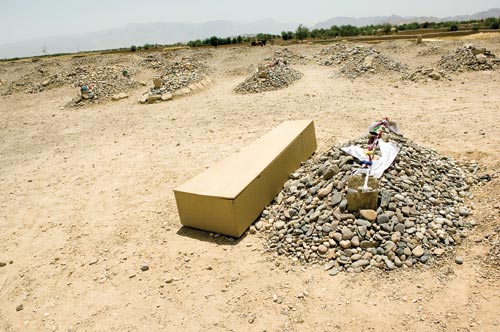Efforts to report on civilian casualties in Afghanistan frequently are hampered by the sheer inaccessibility of the places involved, both topographically and culturally. Taliban strongholds are often situated near remote Pashtun villages that observe strict tribal codes. Guests are protected at all costs. Unwelcome trespassers are fair game. Bala Baluk is no exception. The region was the center of resistance to the Russians in Farah Province in the 1980s, and its economy now is wholly dependent on illegal opium production. Even people from nearby Farah city would never dare to venture in without an invitation.
I was only able to get into Granai because of a string of fortunate coincidences—most importantly, a trusted contact’s best friend is from the village. He knew that the Taliban were thought to be over twenty kilometers away fighting Italian troops. If I came at a time of day when most people were either working or sleeping and stayed just long enough to photograph the areas affected by the air strikes, he thought I would be okay. My friend dressed me like a local and instructed me to keep my face covered and my mouth shut.
As we entered, an almost unearthly silence seemed to envelope Granai. No birds were singing; there was no breeze. Even more unnerving, local children gradually appeared during my tour and silently followed us as we proceeded around craters and ruined buildings. They never spoke, or smiled, or wept. It was as if their trauma had consumed all their feelings. The experience was both eerie and heartbreaking.
The smell of death still hung heavy in the air. Local men had done their best to collect all body parts, but flies still buzzed around the rubble of the two main strikes. I was told that a farmer had found an almost complete corpse in a field just the day before. My guide showed me the spot where he had uncovered the bodies of his sister and nephews. He then walked me to every location where arms, legs, heads, and torsos had been discovered, some of them caught in the branches of trees.
In the most deadly strike a 2000-pound bomb had been dropped into a compound on the far edge of the village where a crowd of terrified people were sheltering. They were mostly women and children who had been evacuated there after the initial air strikes around the village mosque. They had been spotted from the air and mistaken in the dark for fleeing Taliban fighters. I can only imagine the scene that greeted the villagers who returned there at first light.
The cemetery sits about half a mile from Granai. I was shown dozens of fresh graves—some, I was told, containing entire families. Finally, I was led to a mass grave stretching more than a hundred feet across. I was told it contained the remains of fifty-five people. Villagers had buried them together because they were in pieces and it was impossible to identify the scorched limbs and body parts. My guide told me that the final death toll was 147. The International Red Cross and other independent agencies have estimated similar totals.
The Granai massacre was surely not a deliberate act. NATO stands to gain nothing from killing innocents. Such events only fuel the insurgency. However, the US Central Command has yet to accept the body count or discipline anyone involved in the bombing, and the cockpit footage from the B-1B flown over the village of Granai that night remains classified to this day.







